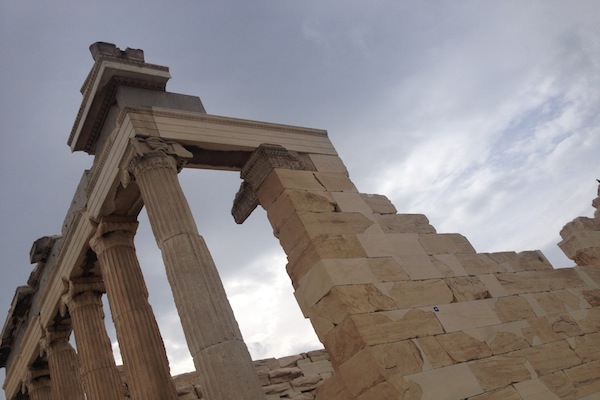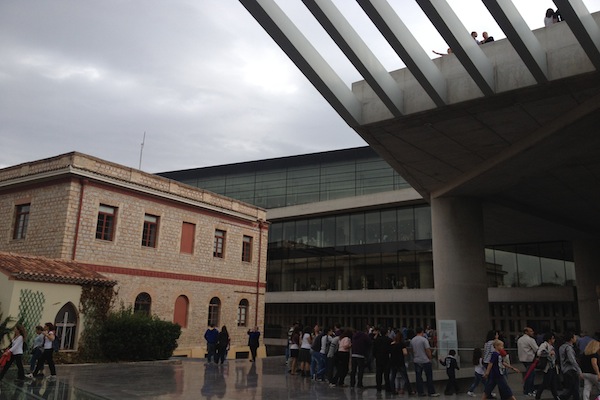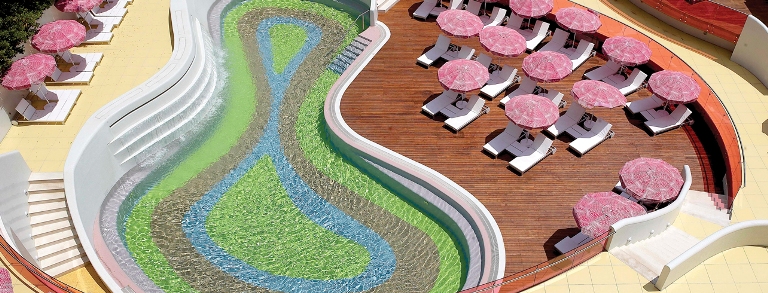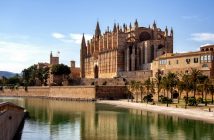In London, if you know whereabouts to look, you can enjoy pints of India Pale at the bars down the same darkening lanes where Gladstone used to amble late at night finding fallen girls to take home and cleanse. In Paris, you can take a romantic stroll with your significant other across the squares where royal apologists used to have their heads ceremonially hacked off.
The charms of old cities are manifold. One of them is to stride gracelessly over the legends and sagas written into the stonework of their every pavement, like so many coach-loads of t-shirted tourists. Or, if you prefer, to stand upon the same spot and look across the same horizon as generations long since rendered dust-bound, and marvel at the sheer remarkable fact that we’re still here.

It’s eleven o’clock on an unseasonably mild Sunday morning in October. Behind me, the blue and white colours of the Greek standard flutter in the breeze. I’m standing amid a polyglot chorus of holiday-makers and day-trippers on top of the Acropolis, Instagramming a cityscape of northern Athens and sharing it on Facebook: a pan-continental gloat to the handful of friends who pay the slightest attention to anything I share back home in the colourful chill of the English mid-autumn.
By chance it happens to be Ohi Day, the anniversary of the morning in 1940 when Prime Minister Metaxas was presented with an ultimatum by the Italian ambassador, demanding that Greece allow the Axis forces to enter his country—to which he replied “Alors, c’est la guerre”, recollected in the popular consciousness more simply as “Ohi!”, “No!”.

This morning, the national monuments and museums have opened their doors free of entry to mark the occasion. This year, at a time of biting austerity and political strife across Athens and Greece, fears are brewing of clashes on the streets between the band of bully-boy fascists who have been gaining followers of late and their anxious opponents. Just days ago, in a desperate appeal to history aimed squarely at Chancellor Merkel when she was greeted by protestors in SS uniforms on a recent visit to the country, the current Greek premier compared the Athens of 2012 to the Weimar Berlin of 1932.
Layer upon layer of politics and history, of civilization and humanity—played out through the lens of my iPhone camera. But behind me, behind the shutter-snapping tourists and the waving flag of the Hellenic Republic, the ancient stone remains of the Parthenon stand with a serene and enduring majesty, the oldest icon of old Athens daily made new at the touch of a button on a thousand more smartphones.
Athens is not the immediate destination of choice for holiday-makers setting off in search of their Greek paradise resort. The turquoise coasts of the islands scattered across the Aegean Sea have long captured the heart: golden sands and quiet streets; Corelli’s Kefalonia and Zorba’s Crete. When visitors go to Athens, it is for the Parthenon, the Acropolis, for the old.
If you know whereabouts to look, there is a fascinating, a striking, a surprising new face to Athens emerging today. One of its foremost bastions is the emblematically named New Hotel, located in the throbbing heart of the modern metropolis, barely a two-minute walk from Syntagma Square—the central plaza which separates the Greek Parliament from the shops, the McDonalds and the tourist tat stalls.
throbbing heart of the modern metropolis, barely a two-minute walk from Syntagma Square—the central plaza which separates the Greek Parliament from the shops, the McDonalds and the tourist tat stalls.
A cosmopolitan, urbane establishment, New Hotel teasingly plays on its own name from the moment its guests step through the glazed doors and into the dimly-lit foyer. Designed by the Campana brothers, New Hotel remains true to the established form of the Brazilian design duo, developing furniture since the 1980s made out of ordinary materials, primarily waste products. “We didn’t want to create another boutique or design hotel,” they say; that they certainly didn’t do.
The recurring motif is of the old made new: the walls of the reception decorated curiously with recycled old bedposts; restaurant chairs taken from second-hand stores; even a newspaper rack made out of a broken stool. The centrepiece of the hotel reception and its adjoining restaurant New Taste is the Favela art installation, a series of rising tree-like sculptural collage made from reclaimed wood.
But for all its superficial embellishment and showmanship, the stay at New Hotel offers all the luxury its five stars promise. New Hotel is one of five across the Greek capital that belongs to the Yes! Hotels chain, which brands itself boldly as Young, Exciting, Seductive—characteristics that might easily be applied to that new Athens of renown.
Each one has its own unique and uncompromising flavour. A short walk uptown is Periscope, a decidedly more urban, minimalist alternative nestled in the heart of exclusive Kolonaki. On the ground floor lies the P-BOX all-day eatery, where a menu ablaze with tantalising fusions of Mediterranean and Asian cuisine inspired by legendary Greek chef Christoforos Peskias whose own international culinary education simmers in every dish. Meanwhile in the leafy northern suburbs, Semiramis could at first sight belong to a radically different chain of hoteliers. Decked garishly on the indoors in light greens and pastel yellows, pink hues and baby blues, its restaurant space leads out to a gloriously inviting swimming pool to bathe and relax beneath the open Athenian summer sky.
This Sunday morning on the edge of the Acropolis I’m standing on the spot where two millennia ago people from across the Greek world came to worship Athena, the patron of Athens. One version of the founding myth of the city tells how Athena competed with the sea god Poseidon to be its patron deity. They agreed each to offer the people of Athens one gift, of which they would choose the one they preferred: Poseidon gave them water, which enabled Athens to rise as a sea power, but the water was unsuitable for drinking; Athena however gave them the olive tree, which brought wood, oil and food—the sustenance that made it possible for civilization to grow and thrive from this intemperate, often sweltering Mediterranean settlement.
It still does. Just two nights ago, internationally-renowned avant-garde stage director Robert Wilson’s acclaimed adaptation of Homer’s Odyssey premiered at the National Theatre of Athens, set to run until next spring. The ancient epic is recast playfully, performed in a casual modern Greek but with enough spectacle and visual appeal to tease a chuckle from audiences even vaguely familiar with the plot from their reluctant teenage classics lessons. The old made new.

From my vantage point on the Acropolis, I see an unusual, dramatic, almost confrontational glass-and-steel monolith down below, down the road from the remains of the Theatre of Dionysus. The new Acropolis Museum was opened to the public in the summer of 2009, designed by Swiss-born Bernard Tschumi such that the Athens sunlight might flood each of its floors—the topmost of which is set at an angle to the rest of the building beneath, exhibiting upon its walls the remaining pieces of the iconic marble frieze from the Parthenon (the bits Elgin didn’t bother with) to which the gallery runs in parallel.
On this unseasonably mild Sunday morning in October, the Greek day stretches on. And I am marvelling that we’re still here.





